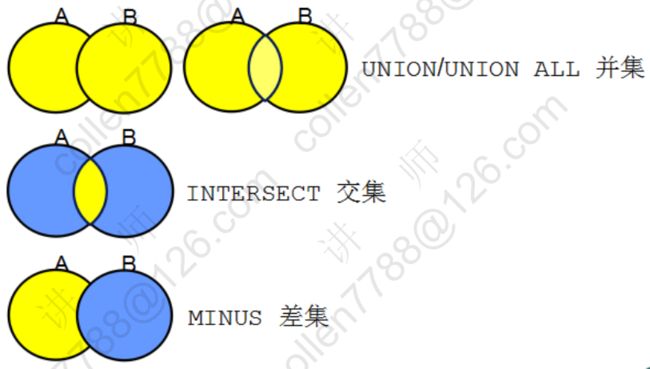子查询和集合运算
一、子查询
语法:
select select_list
from table
where expr operator
(select select_list from table);
子查询(内查询)在主查询之前一次执行完成。
子查询的结果被主查询使用(外查询)。
注意:
子查询要包含在括号内。
将子查询放在条件的右侧。
单行操作符对应单行子查询,多行操作符对应多行子查询。
例:
SQL> --查询工资比SCOTT高的员工信息
SQL> --1. SCOTT的工资
SQL> select sal from emp where ename='SCOTT';
SAL
----------
3000
SQL> --2. 比3000高的员工
SQL> set linesize 200
SQL> select * from emp where sal > 3000;
EMPNO ENAME JOB MGR HIREDATE SAL COMM DEPTNO
---------- ---------- --------- ---------- -------------- ---------- ---------- ----------
7839 KING PRESIDENT 17-11月-81 5000 10
SQL> --子查询所要解决的问题: 不能一步求解
SQL> select *
2 from emp
3 where sal > (select sal
4 from emp
5 where ename='SCOTT');
EMPNO ENAME JOB MGR HIREDATE SAL COMM DEPTNO
---------- ---------- --------- ---------- -------------- ---------- ---------- ----------
7839 KING PRESIDENT 17-11月-81 5000 10
注意的问题:
1. 括号
2. 合理的书写风格
3. 可以在where select having from后面 都可以使用子查询
4. 不可以在group by后面使用子查询
5. 强调from后面的子查询
6. 主查询和子查询可以不是同一张表;只要子查询返回的结果 主查询可以使用 即可
7. 一般不在子查询中排序;但在top-n分析问题中,必须对子查询排序
8. 一般先执行子查询,再执行主查询;但相关子查询例外
9. 单行子查询只能使用单行操作符;多行子查询只能使用多行操作符
单行子查询:只返回一行,使用单行比较操作符
多行子查询:返回多行,使用多行比较操作符
10.子查询中的null
3.可以在where select having from后面 都可以使用子查询:
SQL> select empno,ename,sal,(select job from emp where empno=7839) 第四列
2 from emp;
5.强调from后面的子查询
SQL> --查询员工信息:员工号 姓名 月薪
SQL> select *
2 from (select empno,ename,sal from emp);
--查询员工信息:员工号 姓名 月薪 年薪
select * from (select empno,ename,sal,sal*12 annsal from emp)
思考:
select empno,ename,sal,sal*12 annsal from emp;
select * from (select empno,ename,sal,sal*12 annsal from emp);
以上两条语句性能一样
6.主查询和子查询可以不是同一张表;只要子查询返回的结果 主查询可以使用即可
查询部门名称是SALES的员工:
方式一:使用子查询
select * from emp where deptno=(select deptno from dept where dname='sales');
方式二:使用多表查询
select e.* from emp e,dept d where e.deptno=d.deptno and d.dname='sales';
SQL 优化:尽量使用多表查询
单行比较操作符:
执行单行子查询:
select ename,job,sal from emp
where job =
(select job from emp where empno = 7566)
and sal >
(select sal from emp where empno = 7782);
在子查询中使用组函数
select ename,job,sal from emp where sal =
(select min(sal)
from emp);
子查询中的having子句
首先执行子查询
向主查询中的having子句返回结果
select deptno,min(sal)
from emp
group by deptno
having min(sal) >
(select min(sal)
from emp
where deptno = 10);
多行比较操作符
SQL> --in 在集合中
SQL> --查询部门名称是SALES和ACCOUNTING的员工
SQL> select *
2 from emp
3 where deptno in (select deptno from dept where dname='SALES' or dname='ACCOUNTING');
SQL> --any: 和集合中的任意一个值比较
SQL> --查询工资比30号部门任意一个员工高的员工信息
SQL> select *
2 from emp
3 where sal > any (select sal from emp where deptno=30);
等价于:
select * from emp where sal > (select min(sal) from emp where deptno=30)
SQL> --all 和集合中的所有值比较
SQL> --查询工资比30号部门所有员工高的员工信息
SQL> select *
2 from emp
3 where sal > all (select sal from emp where deptno=30);
等价于:
select * from emp where sal > (select max(sal) from emp where deptno=30)
多行子查询中的null:
SQL> --not in (10,20,null)
SQL> --查询不是老板的员工
SQL> --查询是老板的员工
SQL> select *
2 from emp
3 where empno in (select mgr from emp);
SQL> select *
2 from emp
3 where empno not in (select mgr from emp where mgr is not null);
二、集合运算
集合运算符:
union:返回两个集合去掉重复元素后的所有记录
union all:返回两个集合的所有记录,包括重复的
intersect:运算符返回同时属于两个集合的记录
minus:返回属于第一个集合,但不属于第二个集合的记录
例:
SQL> /*
SQL> 查询10和20号部门的员工
SQL> 1. select * from emp where deptno in (10,20);
SQL> 2. select * from emp where deptno=10 or deptno=20;
SQL> 3. 集合运算
SQL> select * from emp where deptno=10
SQL> 加上
SQL> select * from emp where deptno=20
SQL> */
SQL> select * from emp where deptno=10
2 union
3 select * from emp where deptno=20;
SQL> select deptno,job,sum(sal) from emp group by rollup(deptno,job);
注意的问题:
select语句中的参数类型和个数要一致
可以使用括号改变集合执行的顺序
如果有order by子句,必须放到最后一句查询语句后
集合运算采用第一个语句的表头作为表头
SQL> select deptno,job,sum(sal) from emp group by deptno,job
2 union
3 select deptno,to_char(null),sum(sal) from emp
4 union
5 select to_number(null),to_char(null),sum(sal) from emp;
SQL 优化 5. 尽量不要使用集合运算


